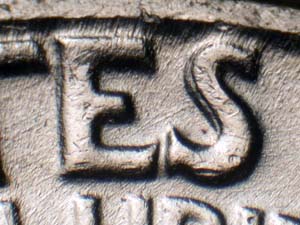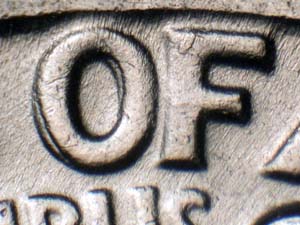
Doubled Dies:
Class VIII: Tilted Hub Doubling
Tilted Hub Doubling
This coin exhibits hub doubling that occurred as a result of either a tilted hub or die when the first hubbing was made. The tilt caused only a small portion of the design to be transferred, usually near the rim of the die. The doubling is the strongest toward the rim and diminishes toward the center. One of the best examples is the 1963-D DDO-001 Lincoln cent, which exhibits doubling of the 3 in the date. This class is also used to describe hub doubling which occurred as a result of the single squeeze hubbing process initiated in 1996. Here the doubling from a tilt is usually limited to the central design elements. When it is not, it is combined with a Class IV: offset hub doubling or Class VI: distended hub doubling.
ES of STATES OF Notice how the doubling is restricted to just this one area but the design is the same
Date
Denomination Description
1963-D 1c DDO-001; 1-O-VIII 1964 1c DDO-022; 22-O-VIII 1964 5c DDO-002; 2-O-VIII 2005-P 5c DDR-026; 26-R-VIII 1941 10c DDO-002; 2-O-IV+VIII
1954 10c DDR-002; 2-R-VIII 1950-D 25c DDR-004; 4-R-VIII
1963-D 25c DDR-001; 1-R-VIII 1950-D 50c DDR-001; 1-R-IV+VIII 1963 50c DDR-004; 4-R-VIII 2007-P $1 Jefferson DDR-001; 1-R-VIII 2007-P $1 Monroe DDR-001; 1-R-VIII
| Home |
Introduction |
Design Changes |
Mintmark Styles |
Doubled Dies |
Mintmark Varieties |
RPDs and MPDs |
Die Errors |
| About CONECA |
About the Author |
Copyright James Wiles, 2011
Email: jameswiles@sbcglobal.net
1490 Trail View Lane
Frisco, TX 75034-2649

